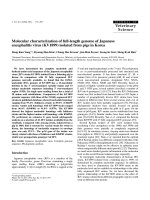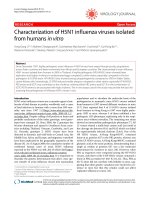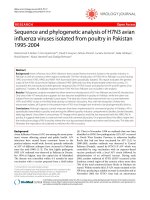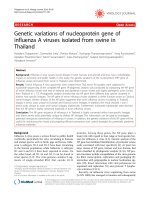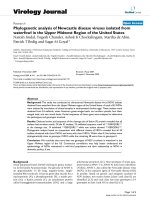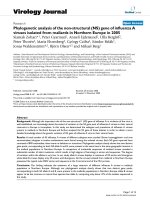Molecular characterisation of clostridium perfringens type D isolated from sheep in Kashmir Himalayas, India
Bạn đang xem bản rút gọn của tài liệu. Xem và tải ngay bản đầy đủ của tài liệu tại đây (282.03 KB, 7 trang )
Int.J.Curr.Microbiol.App.Sci (2018) 7(8): 3682-3688
International Journal of Current Microbiology and Applied Sciences
ISSN: 2319-7706 Volume 7 Number 08 (2018)
Journal homepage:
Original Research Article
/>
Molecular Characterisation of Clostridium perfringens Type D Isolated from
Sheep in Kashmir Himalayas, India
Z.A. Kashoo, S.A. Wani, A.H. Wani*, S.M. Khan, S. Qureshi, I. Hussain,
S. Farooq and J.A. Malla
Niche Area of Excellence, Anaerobic Bacteriology laboratory, Division of Veterinary
Microbiology and Immunology, Faculty of Veterinary Sciences and Animal Husbandry,
SKUAST-Kashmir, Shuhama, Srinagar-190006, India
*Corresponding author
ABSTRACT
Keywords
Clostridium
perfringens,
Enterotoxaemia,
Toxinotype, 16S
rRNA, Multiplex
PCR, cpa, cpb, etx.
Article Info
Accepted:
20 July 2018
Available Online:
10 August 2018
The molecular characterization of Clostridium perfringens in sheep for various
toxinotypes was investigated in this study. A total of 147 samples collected from
healthy, diarrhoeic animals and morbid material of animals suspected to have died
of enterotoxaemia were screened for Clostridium perfringens (C. perfringens)
toxinotypes. The polymerase chain reaction (PCR) amplification of 16S rRNA
gene revealed that out of 147 samples collected, 92 (62.58%) were found positive
for C. perfringens. All the 92 isolates were screened for three toxin genes viz.,
cpa, cpb and etx using a multiplex PCR. Toxinotyping revealed that 65 (72.65%)
were positive for Clostridium perfringens Type A and 27 (29.34%) were that of
Clostridium perfringens Type D None of the isolates was found to be toxinotype B
or C.
Introduction
Clostridium perfringens is one of the
ubiquitous organisms among clostridial
species. It is the common inhabitant of
gastrointestinal tract of humans and animals
and also occurs in the soil. It is relatively aerotolerant, spore forming, non-motile, Grampositive rods (0.6-0.8 2-4 µm). The spores
are oval, sub-terminal and bulge from the
mother cell (Prescott et al. 2016). On the basis
of four major toxins viz., alpha [CPA], beta
[CPB], epsilon [ETX], and iota [ITX] the C.
perfringens is divided into five toxinotypes
i.e., A, B, C, D and E. The toxinotypes were
distinguished using mouse lethality tests and
checking sero-protection with neutralizing
antibodies raised against culture supernatants
of the representative C. perfringens toxinotype
(Sterne and Batty, 1975). The toxin production
3682
Int.J.Curr.Microbiol.App.Sci (2018) 7(8): 3682-3688
depends on the specific toxinotype while all
isolates of C. perfringens from animals
produce alpha-toxin (CPA), and more than
98% produce theta toxin, also known as
perfringolysin O (Songer, 1996). The specific
toxins are responsible for the clinical signs
and a syndrome attributable to each type. The
specific enteric infections of various animal
species are associated to different toxinotypes
(Ohtani and Shimizu. 2016, Ashgan. 2013)
The C. perfringens toxinotype D produces
alpha and epsilon toxins and is responsible for
ovine
enterotoxaemia
and
caprine
enterocolitis. Enterotoxaemia is an acute,
highly fatal intoxication that affects sheep,
lambs, kids and goats. Sheep of all ages are
affected by enterotoxaemia, but lambs under
10 weeks of age are most susceptible as they
are nursed by heavy-lactating ewes and the
weaned lambs on lush pasture or in feedlots
(Songer, 1996).
In 2010-11, livestock generated a total of 4%
of the GDP and 26% of the agricultural GDP
in India. Sheep rearing is considered to be one
of the major contributors to the livestock
sector. The economics of sheep farming
depends largely on the survival of the lambs
and later lambing percentage of adult stock. A
study showed that enterotoxaemia (incidence
rate-1.5%, death rate-2.4% and case fatality
rate-30.8%) comes next to diseases like blue
tongue, PPR, and anthrax with respect to
incidence and death rate in India (Singh and
Prasad. 2009). The prevalence rates of
enterotoxaemia due to C. perfringens
toxinotype D ranging between 24.13% and
100% have been reported and the disease is
considered one of the most frequently
occurring diseases of sheep and goats
worldwide (El Idrissi and Ward. 1992, Greco.
2005).
The present study investigated the prevalence
of Clostridium perfringens (C. perfringens), in
sheep and goats of Kashmir valley as well as
characterized the genotype of its isolates. This
study documented the presence of C.
perfringens toxinotype A and D in sheep and
goats in Kashmir valley.
Materials and Methods
Samples
A total of 147 samples comprising of faecal
material, intestinal contents, kidneys and
abomasum pieces were collected from sheep.
Out of the 147 samples, 105 faecal materials
were from healthy, 36 faecal materials from
diarrhoeic animals and 6 were from carcasses.
The samples were collected in sterile vials
from animals of different age groups.
Isolation and identification of C. perfringens
For isolation of C. perfringens, samples were
inoculated in DifcoTMCooked meat medium
(Becton, Dickinson and Company, Sparks,
MD, USA) and incubated anaerobically in 3.5
litre anaerobic jar (Oxoid Limited, Thermo
Fisher
Scientific
Inc.,
UK)
with
GasPakTMAnaerobe
Container
System
(Becton, Dickinson and Company, Sparks,
MD, USA) at 37°C for 24 hrs. Enriched
samples were streaked on Sulphite Polymixin
Sulphadiazine agar plates (SPS HiVegTM
Agar, Modified; Hi-Media laboratories,
Mumbai, India) and the plates were incubated
anaerobically at 37°C for 24 hrs. After
incubation
suspected
colonies
were
subcultured on the SPS agar plates until they
were free from contaminating bacteria. The
pure cultures of C. perfringens toxinotypes
were lyophilized for future use in the
laboratory using
0.25M
sucrose
as
cryoprotectant.
Confirmation of the isolates was done by
demonstration of the typical cellular
morphology in Gram’s stained smear, standard
3683
Int.J.Curr.Microbiol.App.Sci (2018) 7(8): 3682-3688
biochemical tests and detection of C.
perfringens by species specific polymerase
chain reaction (PCR) using 16S rRNA gene
primers.
Molecular
characterization
perfringens isolates
of
C.
94ºC for 30 sec, annealing at 49ºC for 90 sec
and extension at 72ºC for 90 sec. This was
followed by final extension at 72ºC for 10
min. The DNA of C. perfringens Type D
isolate obtained from Sheep Husbandry
Department was used as positive control.
Multiplex PCR of virulent genes
Bacterial DNA isolation
Suspected isolated colonies from agar plates
were suspended in 1.5 ml microcentrifuge
tubes containing 100 μl of distilled water by
gentle vortexing. The samples were boiled for
5 min, cooled on ice for 10 min and
centrifuged at 10,000×g in a table-top
microcentrifuge
(Cooling
Centrifuge,
Eppendorf 5418R, Hamburg, Germany) for 1
min. Three microlitres (μl) of the supernatant
was used as the template for PCR.
Polymerase chain reaction
All the PCR assays in this study were
performed in 25 µl reaction volume in
Mastercycler gradient (Eppendorf AG,
Hamburg, Germany). The reaction consisted
of 3.0 µl template DNA, 2.5 µl of 10X buffer,
0.2 µl of 25mM dNTP mix, 1 U of Taq DNA
Polymerase (Fermentas Life Sciences) and
sterile distilled water. The MgCl2 was used at
2.0 mM concentration, unless otherwise
indicated. Sterilized distilled water was used
as negative controls. All the primers were
acquired from GCC Biotech, Kolkata, India.
16S rRNA gene amplification
After identification of C. perfringens by
phenotypic characteristics like colony
characteristics, Gram’s staining, the isolates
were further confirmed using species-specific
primers (Table 1) targeting 16S rRNA gene of
the C. perfringens. The PCR conditions
consisted of initial denaturation at 95ºC for 15
min, followed by 35 cycles of denaturation at
All the C. perfringens isolates were screened
for three different toxin genes using a
multiplex PCR. These three toxin genes
include α-toxin (cpa), β-toxin (cpb) and εtoxin (etx). The primers used for the
amplification of the genes are shown in Table
1. The PCR conditions were similar to that
used for amplification of 16S rRNA gene
except for the annealing temperature that was
set at 53ºC. The amplified products were
electrophoresed in 1.5% agarose gel (Sigma
Aldrich, St. Louis, USA) and stained with
ethidium bromide (0.5 µg/ml). Amplified
bands were visualised and photographed under
UV illumination (Ultra Cam Digital Imaging,
Ultra. Lum. Inc., Claremont, CA).
Results and Discussion
From 147 samples collected from sheep, 92
(62.58%) carried C. perfringens. All the 92
isolates
were
morphologically
and
biochemically identified by Gram staining,
capsular staining, lecithenase activity on egg
yolk agar media, triple sugar iron (TSI) test
and formation of double zone of haemolysis
on 5% sheep blood agar (Fig. 1) as C.
perfringens. These isolates amplified 481bp
product (Fig. 2) corresponding to C.
perfringens.
Out of a total of 92 isolates from sheep, 65
(70.65%) were found to carry cpa gene alone
as a major toxin gene, thus were designated as
toxinotype A. While the remaining 27
(29.34%) harboured both cpa and etx genes,
thus were designated as toxinotype D. None of
3684
Int.J.Curr.Microbiol.App.Sci (2018) 7(8): 3682-3688
the isolates carried cpb gene indicating the
absence of C. perfringens toxinotype B or C in
sheep samples (Fig. 3). The C. perfringens
isolates were characterized for important
virulence factors including cpa, cpb and etx.
Among lambs the occurrence of toxinotype D
(55.76%) was higher than that of toxinotype A
(Table 2). Among adult sheep occurrence of
toxinotype A (60%) was higher than that of
toxinotype D. Clostridium perfringens
toxinotypes are responsible for varied disease
syndromes in livestock animals and poultry. In
the present study, healthy as well as suspected
sheep populations from different regions of
Kashmir valley were screened for the presence
of C. perfringens toxinotypes. Our findings
revealed that 92 (62.58%) of 147 samples
from sheep were positive for C. perfringens
based on isolation and PCR amplification of
16S rRNA gene. In accordance with our study,
a lower occurrence of 24.13% of C.
perfringens in sheep of Morocco (el Idrissi
and Ward. 1992) while as a higher prevalence
of 100% of C. perfringens in sheep of Italy
(Greco. 2005) has been recorded. Similarly,
prevalence of 59.62% of C. perfringens in
sheep was reported in Andhra Pradesh, India
(Kumar. 2014)[9]. The prevalence of 96.92%
of C. perfringens in sheep and goats in
Switzerland has been reported (Miserez.
1998). Recent reports by Rasool et al. (2017)
reported prevalence of C. perfringens to the
tune of 44.94% from sheep in Kashmir valley
where type A was most prevalent
corroborating with our study. Similar study in
this region by Nazki et al. (2017) reported
prevalence of 72.36% from sheep.
Table.1 List of primers used in PCR for amplification of Clostridium perfringens toxin
Genes
S. No.
Target
gene
Primer Sequence (5′-3′)
1.
16S rRNA
2.
cpa
3.
cpb
4.
etx
F-TAACCTGCCTCATAGAGT
R- TTTCACATCCCACTTAATC
F-GCTAATGTTACTGCCGTTGA
R-CCTCTGATACATCGTGTAAG
F‒GCGAATATGCTGAATCATCA
R‒GCAGGAACATTAGTATATCTTC
F‒TGGGAACTTCGATACAAGCA
R‒AACTGCACTATAATTTCCTTTTC
C
Primer
conc.
(µM)
0.4
Product size
(bp)
Reference
481
0.4
324
Tonookaet al.
(2005)
van Astenet al.
(2008)
0.4
195
0.4
376
Table.2 Details of the isolates of C. perfringens from adult sheep and lambs
Age
Group
Healthy/
Diarrhoeic
No. of samples
screened
Type A
Type D
59
10 +1*=11
Number
positive for
C.
perfringens
33
7
Adult
Healthy
Diarrhoeic
21
3
12
4
Young
Healthy
Diarrhoeic
46
26 + 5* =31
147
28
24
92
15
8
47
13
16
45
*caracass samples
3685
Int.J.Curr.Microbiol.App.Sci (2018) 7(8): 3682-3688
Fig.1&2 Double zone of hemolysis produced by C. perfringens on sheep blood agar &
Amplicons of 16S rRNA gene based PCR
Lane M: 100bp DNA ladder
Lane 1: Negative control
Lane 2: Positive control
Lanes 3-4: Isolates positive for C. perfringens
Fig.3 Multiplex PCR amplicons of different virulence genes of Clostridium perfringens
Lane M: 100bp DNA ladder
Lane 1: Positive control of C. perfringensType D with amplified cpa(324bp) and etx(376bp)
genes. Lane 2: Negative control, Lane 3: C. perfringensType D,
Lane 4:
C. perfringensType D with amplified cpa,etx and beta2(548bp) genes
Lane 5: C. perfringensType D with amplified cpa,etx and cpe(485bp) genes
Lane 6: C. perfringens Type A with cpagene amplification
In the present study, C. perfringens
toxinotype D was more prevalent among
lambs (56.16%) than adult sheep. Our
findings are in agreement with Redostitis et
al. (2007), who reported that enterotoxaemia
is more prevalent in lambs aged between 3-8
weeks, in fattening lambs in United Kingdom.
The authors attributed it to the heavy feeding
and milking of lambs by ewes that are grazed
on lush pastures. However, they also observed
3686
Int.J.Curr.Microbiol.App.Sci (2018) 7(8): 3682-3688
its higher prevalence in adult animals grazed
on luxurious pastures. The spillover of the
carbohydrate and protein rich nutrients into
the small intestine from the abomasum
encourages rapid multiplication of organisms
and production of ETX. The increased
prevalence of C. perfringens Type D
(21.65%) in lambs than healthy adult sheep
(3.7%) has been reported in Andhra Pradesh,
India (Kumar. 2014). Recent studies by
Rasool et al. (2017) and Nazki et al. (2017)
also reported that majority of type D isolates
were from diarrhoeic lambs occurrence of
58.6% and 56.16% respectively of type D
isolates which endorse our results.
Clostridium perfringens isolates obtained in
this study were screened for presence of three
toxin genes viz., cpa, cpb and etx. Out of 92
isolates from sheep, 65 (70.65%) were found
positive only for cpa toxin gene, thus
belonged to toxinotype A, while the 27
(29.34%) carried both cpa and etx toxin genes
thus belonged to toxinotype D. None of these
isolates possessed cpb toxin gene, indicating
absence of C. perfringens toxinotype B or C.
These findings are in agreement with the
observations reported from the Italy in which
84% of C. perfringens isolated from the
lambs and kids in Italy is toxinotype A and
the remaining 16% as toxinotype D and none
belonged to type B, C or E (Greco. 2005). In
India 69.29% prevalence of enterotoxaemia
from suspected sheep flocks and 39.71% from
healthy sheep flocks has been reported
(Kumar. 2014). Genotyping of the isolates
from healthy animals indicated the presence
of toxinotype A and D to be 45.56% and
31.64%, respectively. Although, toxinotype C
has not been reported from sheep in the
present study, the presence of toxinotype B or
C cannot be ruled out owing to the fact the
study being preliminary and based
comparatively on small sample size.
In conclusion, this study documents the
prevalence, isolation and characterization of
C. perfringens toxinotype D in sheep of
Kashmir valley. The study concluded that, C.
perfringens was prevalent among lambs in
Kashmir valley and toxinotype A being most
prevalent toxinotype in sheep. Absence of
toxinotypes B and C in this study does not
indicate the absence of these toxinotypes in
the sheep population as the number of
samples was comparatively less. The present
work also made local strains of C. perfringens
available for formulation of vaccine, to
effectively control the menace in the state.
References
Ashgan, M., Al-Arfaj, A.A. and Moussa, I.
2013. Identification of four major
toxins of Clostridium perfringens
recovered from clinical specimens.
African Journal of Microbiology
Research, 7: 3658-3664
El Idrissi, A.H. and Ward, G.E. 1992.
Evaluation
of
enzyme-linked
immunosorbent assay for diagnosis of
Clostridium
perfringens
enterotoxemias.
Veterinary
Microbiology, 31(4): 389-396.
Greco, G., Madio, A., Buonavoglia, D.,
Totaro, M., Corrente, M., Martella, V.
and
Buonavoglia,
C.
2005.
Clostridium perfringens toxin-types in
lambs and kids affected with
gastroenteric pathologies in Italy. The
Veterinary Journal, 170: 346-50.
Kumar, N.V., Sreenivasulu, D. and Reddy,
Y.N. 2014. Prevalence of Clostridium
perfringens toxin genotypes in
enterotoxemia suspected sheep flocks
of Andhra Pradesh. Veterinary World
7: 1132-6.
Miserez, R., Frey, J., Buogo, C., Capaul, S.,
Tontis, A., Burnens, A. and Nicolet, J.
1998. Detection of alpha- and epsilontoxigenic Clostridium perfringens
Type D in sheep and goats using a
DNA amplification technique (PCR).
3687
Int.J.Curr.Microbiol.App.Sci (2018) 7(8): 3682-3688
Letters in Applied Microbiology., 26:
382-386.
Nazki, S., Wani, S.A., Parveen, R., Ahangar,
S.A., Kashoo, Z.A., Hamid, S., Dar,
Z.A., Dar, T.A., and Dar, P.A. 2017.
Isolation, molecular characterization
and prevalence of Clostridium
perfringens in sheep and goats of
Kashmir Himalayas, India. Veterinary
World 10: 1501–1507.
Ohtani, K. and Shimizu, T. 2016. Regulation
of toxin production in Clostridium
perfringens. Toxins (Basel), 8: 207
Prescott, J.F., Uzal, F.A., Songer, J.G. and
Popoff M.R. 2016. Brief Description
of Animal Pathogenic Clostridia.
Clostridial Diseases of Animals, Pp.
13-9.
Rasool, S., Hussain, I., Wani, S.A., Kashoo,
Z.A., Beigh, Q., Nyrah, Q., Nazir, N.,
Hussain, T., Wani, A.H. and Qureshi,
S. 2017. Molecular Typing of
Clostridium perfringens Isolates from
Faecal Samples of Healthy and
Diarrhoeic Sheep and Goats in
Kashmir, India. International Journal
of Current Microbiology and Applied
Sciences 6: 3174-3184.
Redostitis, O.M., Gay, C.C., Hinchcliff, K.H.
and Constable, P.D. 2007. Veterinary
Medicine. 10th ed. Saunders Elsevier,
London. p. 773-9.
Singh, B. and Prasad S. 2009. A model based
assessment of economic losses due to
some important diseases in sheep in
India. Indian Journal of Animal
Science 79: 1265-1268.
Songer, J.G. 1996. Clostridial enteric diseases
of
domestic
animals.
Clinical
microbiology reviews 9: 216-34.
Sterne, M. and Batty, I. 1975. Pathogenic
Clostridia. Butterworth & Co.
How to cite this article:
Kashoo, Z.A., S.A. Wani, A.H. Wani, S.M. Khan, S. Qureshi, I. Hussain, S. Farooq and Malla,
J.A. 2018. Molecular Characterisation of Clostridium perfringens Type D Isolated from Sheep
in Kashmir Himalayas, India. Int.J.Curr.Microbiol.App.Sci. 7(08): 3682-3688.
doi: />
3688



